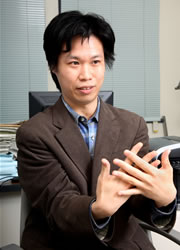2010/11/01
Bridging the worlds of structural systems and mathematical engineering through “mathematical modeling in applied mechanics”
Associate Professor Yoshihiro Kanno
(Department of Mathematical Informatics)

It is harder to compute the deflection of a physical phenomenon when an object is placed on a soft thin film than on a hard flat plate because the position and direction of wrinkles cannot be predicted in advance in case of a film. Associate Professor Kanno uses math called “mathematical modeling in applied mechanics” as a tool to connect the worlds of structural systems and mathematical engineering when solving such nonlinear problems in mechanics including “contact problems.”
In traditional mechanics, it was harder to solve a problem with a film because computation could not carry on without case analysis of a controlling condition in a physical phenomenon, for example whether wrinkles are generated or not on a thin film. However, by using “mathematical modeling in applied mechanics”, one can once hide case analysis so it is also easy to solve a problem with a film. It is mentioned in his recent book "Nonsmooth Mechanics and Convex Optimization” (CRC Press) that this method is useful to solve various nonlinear phenomena of discontinuous properties including whether objects come into contact, stop due to friction, get tense or loosen when a rope is pulled. The key to capture the essence of a physical phenomenon (matter) is to write a clear formula.
To efficiently and accurately solve a difficult problem means to be able to conduct many experiments (simulations). It also means to contribute to safety and validating an existing design method while reducing cost.
Associate Professor Kanno's study is threefold: mechanical behavior analysis of special mechanical systems as in the aforementioned contact problem, proposal of a new design method of structures with consideration for uncertainty, and an optimum design method of mechanical systems, in order to establish mathematical modeling in applied mechanics that captures a physical phenomenon from various perspectives. The time is not far off when he will lead us into a new world using the promising tool, “mathematical modeling in applied mechanics.”

